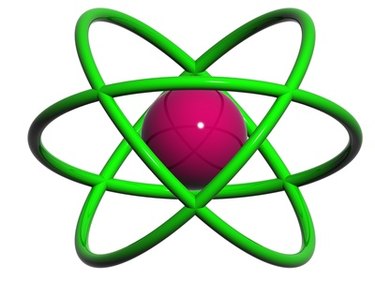Things You'll Need
Seven polystyrene balls
Three small polystyrene balls
Red, green and yellow paint (Not solvent based)
Paintbrush
Two 4-inch lengths of stiff wire
One 8-inch length of stiff wire
Ten cocktail sticks
Wire cutters
Glue
Small block of polystyrene

Lithium is the lightest metal known. Lithium-ion (Li-ion) batteries are at the cutting-edge of battery design, delivering more power for the weight than any other battery. Lithium, however, is highly inflammable in oxygen, making Li-ion batteries some of the most dangerous batteries too. A model of a lithium atom consists of three protons, four neutrons, and three electrons. Creating a model lithium atom requires some dexterity and the ability to use simple tools such as paintbrushes, wire-cutters, and glue.
Step 1
Paint the seven balls representing protons and neutrons. Push a cocktail stick into each ball, and holding it by the stick, paint four of them with red paint. Push the cocktail sticks into a flat block of polystyrene and leave the balls to dry. While the red balls are drying, insert sticks into the remaining three large balls and paint them green. Push these sticks into the polystyrene block and leave them to dry too. Repeat with the smaller balls representing three electrons, coating them with yellow paint.
Video of the Day
Step 2
Remove the sticks once the paint is dry. Using wire-cutters, cut the cocktail sticks into one-inch strips. Push the sticks into the red and green balls to link them into a tight bundle as close to a sphere as possible. When you are happy with the shape of the nucleus, add glue between the balls and allow it to set.
Step 3
Add electrons in two different orbits around the nucleus. Insert two four-inch wires into the nucleus, with the wires pointing straight out. Insert both wires to the same depth, and then impale a yellow ball on the outer end of each wire. Insert an eight-inch wire at a different point on the nucleus and impale the final yellow ball on the outer end of this wire.
Tip
Use clear plastic rods instead of wire to hide the electron supports.
Spread the electrons across the nucleus, rather than bunching them together, to give a better impression of orbiting the nucleus.
Warning
Solvent based paints may dissolve polystyrene and some types of plastic.
Polystyrene is flammable. Keep it away from naked flames.
This classical model of an atom does not fit the modern understanding of the movement of electrons, but fits the basic concept of electrons in orbits around the nucleus.
Video of the Day